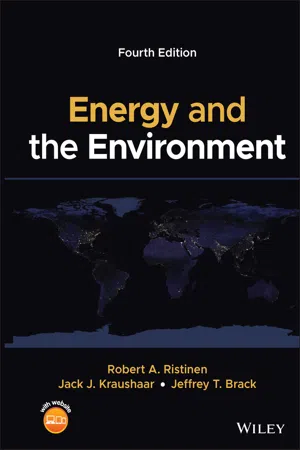
- English
- ePUB (mobile friendly)
- Available on iOS & Android
Energy and the Environment
About this book
Examine the tension between energy production and consumption and environmental conservation with the latest edition of this widely read text
In the newly revised Fourth Edition of Energy and the Environment, the authors deliver an insightful and expanded discussion on the central topics regarding the interaction between energy production, consumption, and environmental stewardship. The book explores every major form of energy technology, including fossil fuels, renewables, and nuclear power, wrapping up with chapters on how energy usage affects our atmosphere, and the resulting global effects.
The latest edition includes new figures and tables that reflect the most recent numbers on conventional and renewable energy production and consumption. The history and current status of relevant U.S. and international governmental energy legislation is discussed along with the text. Readers will also find:
- A thorough introduction to the fundamentals of energy and energy use in industrial societies, including the forms of energy, scientific notation, and the principle of energy conservation
- A comprehensive exploration of fossil fuels, including petroleum, coal, and natural gas, along with their history, world production, and remaining future resources
- Discussion of the pros and cons of nuclear power, it's rise in China, and it's fall elsewhere, and a history of power plant accidents
- A practical discussion of heat engines, including their thermodynamics, energy content of fuels, and heat pumps and engines
- In-depth examinations of new innovations and rapidly increasing use of renewable energy sources, including solar, wind, hydro, geothermal, and biomass energy, along with updates on battery technology and alternative energy storage techniques
- Detailed discussions of the atmospheric effects of our energy usage on scales both local and global; reports from the International Panel on Climate Change; the carbon budget, carbon capture and storage, and geoengineering
Perfect for either graduate or upper-level undergraduate students of physics, environmental science, and engineering, Energy and the Environment is also an indispensable resource for anyone professionally or personally interested in climate change, energy policy, and energy conservation.
Frequently asked questions
- Essential is ideal for learners and professionals who enjoy exploring a wide range of subjects. Access the Essential Library with 800,000+ trusted titles and best-sellers across business, personal growth, and the humanities. Includes unlimited reading time and Standard Read Aloud voice.
- Complete: Perfect for advanced learners and researchers needing full, unrestricted access. Unlock 1.4M+ books across hundreds of subjects, including academic and specialized titles. The Complete Plan also includes advanced features like Premium Read Aloud and Research Assistant.
Please note we cannot support devices running on iOS 13 and Android 7 or earlier. Learn more about using the app.
Information
1
Energy Fundamentals, Energy Use in an Industrial Society

1.1 Introduction

Table of contents
- Cover
- Table of Contents
- Series Page
- Title Page
- Copyright
- Preface
- Acknowledgment
- About the Companion Website
- 1 Energy Fundamentals, Energy Use in an Industrial Society
- 2 The Fossil Fuels
- 3 Heat Engines
- 4 Renewable Energy Sources I
- 5 Renewable Energy Sources II
- 6 The Promise and Problems of Nuclear Energy
- 7 Energy Conservation
- 8 Transportation
- 9 Air Pollution
- 10 Global Effects
- Appendix
- Answers to Selected End-of-Chapter Problems
- Index
- End User License Agreement